Microsoft Surface Review
by Anand Lal Shimpi on October 23, 2012 9:01 PM EST- Posted in
- Tablets
- Microsoft
- Mobile
- Surface
- Windows RT
Display: Not Retina, But Still Good
Surface features a 10.6 inch, 1366 x 768 16:9 display. The physical size is a bit unusual, although the display resolution is something we’ve seen used in affordable notebooks for years now. We already know why Microsoft picked the display size (to enable better multitasking and make for a good keyboard size), but is there room for a flagship tablet with only a 1366 x 768 display resolution?
Microsoft’s response to the resolution question is that more pixels isn’t necessarily better, and that there are a number of other factors that are just as important. It also is quick to point out that a significantly higher resolution display would have increased memory bandwidth requirements, decreased UI frame rate and required a larger battery. As NVIDIA’s Tegra 3 only has a single channel LPDDR2 memory interface, driving a 2048 x 1536 panel and maintaining Microsoft’s UI performance requirements was out of the question. Apple ran into the same issue and ended up building the A5X SoC with an insanely wide memory interface to deal with it. Down the road I’d expect the memory bandwidth problem to get solved, but that still leaves a power consumption issue. Apple moved to a 42.5Wh battery in the 3rd generation iPad, a 37% capacity increase compared to the 31Wh unit in Surface. Enabling a similar panel would have pushed size and weight of Surface more than Microsoft would have liked.
Given those constraints Microsoft chose a different route with Surface. Rather than focus on pixel density it focused on improving contrast and reducing glare. Surface laminates the cover glass and LCD panel together, removing an annoying air gap that’s responsible for some reflections/glare and a reduction in brightness. Apple’s recently announced 8th generation iMac does something similar, as do a lot of high end smartphones, but Surface is among the first to do so with a ~10-inch LCD. The effect is noticeable in a contrived photo but it also results in a display that’s not half bad to look at.
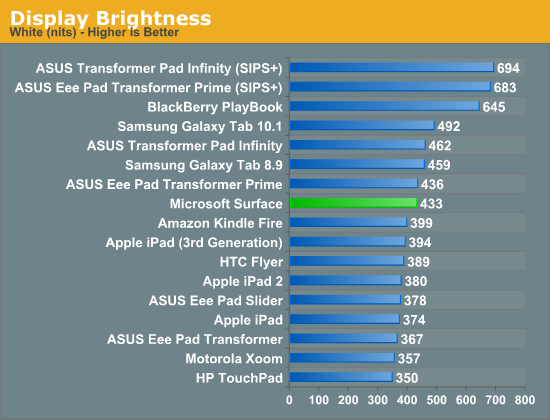
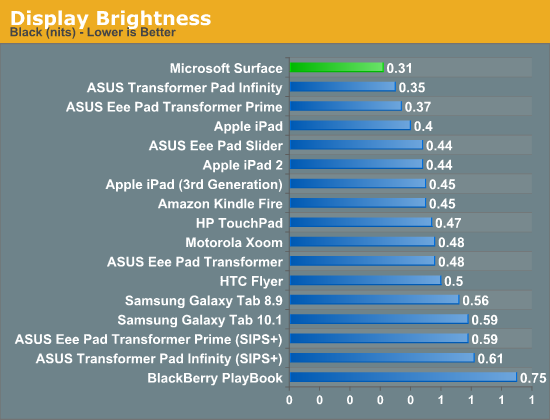
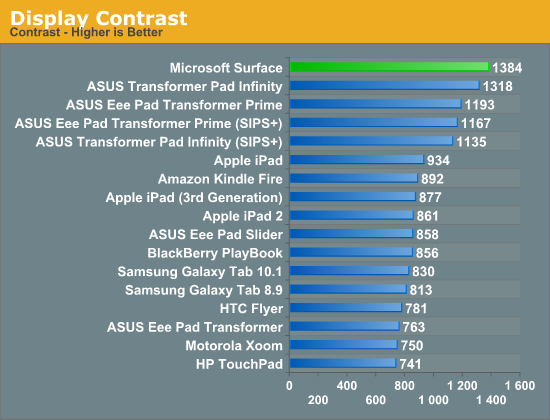
With the exception of text on web pages, the lower resolution Surface display isn’t overly bothersome. I would like something a bit higher resolution although I don’t know that matching Apple’s pixel density is absolutely necessary if Microsoft can deliver elsewhere.
Apple doesn’t just rely on resolution to sell the iPad’s Retina Display, it also happens to do quite well at accurately representing colors. I put Surface through AnandTech Senior Display Editor, Chris Heinonen’s excellent tablet/smartphone analysis workflow to see how well it did:
| CalMAN Display Comparison | ||||||
| Apple iPad (3rd gen) | Apple iPad 2 | ASUS Transformer Pad Infinity | Microsoft Surface | |||
| Grayscale 200 nits Avg dE2000 | 3.7333 | 1.3826 | 3.9881 | 3.6769 | ||
| CCT Avg (K) | 6857K | 6632K | 6632K | 6407K | ||
| Saturation Sweep Avg dE2000 | 3.193 | 6.8404 | 6.8404 | 7.3617 | ||
| GMB Colorchecker Avg dE2000 | 3.0698 | 3.8957 | 4.4177 | 5.3057 | ||
Saturation

Gamut
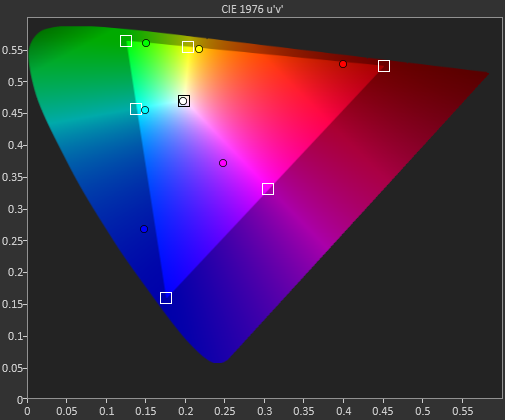
GMB Color Checker
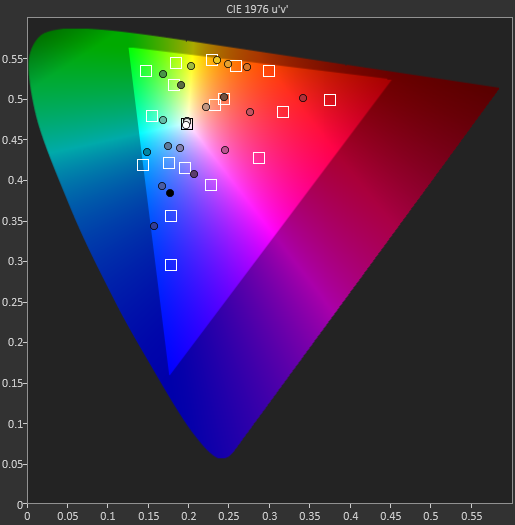
Grayscale accuracy is slightly better on Surface compared to the iPad, however the rest of the accuracy metrics show Apple’s tablet ahead of Surface.
This isn’t to say that Surface’s display is bad, in fact I think it’s quite good and I’d argue that it was never a problem in my testing, but it’s definitely not the best on the market today. I’m also not sure how much of this has to do with Microsoft’s panel selection vs. software calibration. None of my calibration tools work under Windows RT so I couldn’t really tell you.
I did reach out to Microsoft and they did say that some of my values in the charts below looked a little off. I’ll be rerunning data on another Surface sample as soon as I get a chance to.










235 Comments
View All Comments
The0ne - Wednesday, October 24, 2012 - link
A few things that caught my attention that would push me to buy one,"Surface is both larger and heavier than the iPad, both design decisions on Microsoft’s part to built a device that could better deal with Windows RT’s multitasking capabilities as well as make room for a comfortable typing area when used with one of its two keyboard covers."
"Whether or not Surface is priced appropriately really depends on how much you value Windows RT and getting Office 2013 for free. I suspect if you’re already a big Office user, you’ll see a lot of value in the bundle."
As much as I abhor the ribbon style in Office, I absolutely love the 2013 Office preview, its metro style UI, the fluidity of working around int he apps. Seriously I love this new office, its such a joy to work in them with the "metro" style inclusions. Therefore getting it for free is a nice touch if I consider buying one. FYI, I have all 3 versions running side by side to test (2003, 2010 and 2013) and 2013 is just so smooth to work in I can live with the ribbon bar (with my fully customized custom bar of course).
As for the weight and comfortable typing, that's even better to use the tablet as a notebook for work and on the road. Can't wait.
Subyman - Wednesday, October 24, 2012 - link
It looks like MS is moving in the right direction. I like how they are splitting the difference between serious computing and be very mobile, unlike what Apple has done. Apple totally killed productivity with the iPad and seem to be trying to go back and mend that decision. MS is offering professionals options for typing, but the device is still totally usable by the normal consumer.I will be interested once the hardware become a bit more powerful. Win RT looks to be hammering the little ARM processor, but that will be worked out over the next year or so.
JoeA - Wednesday, October 24, 2012 - link
Well balanced and written article with positive attributes and things that still can be improved. I’m an early adaptor because I physically work with tech and installs. I’m looking forward to Rev 2 and 3. The transition will not be as hard as some make it out to be. Have fun and yes agreed it’s just different and works very well.Bob Todd - Wednesday, October 24, 2012 - link
Nice review. While there's always something better around the corner, this feels like really unfortunate timing on the CPU/SOC release schedule. On the low end we've got A9 ARM parts at the end of their competitive life, with A15 around the corner (or S4 Pro here would have been sweet). In the middle ground we've got Windows 8 tablets running a 5 year old Atom architecture that's finally about to be overhauled and shrunk to 22nm. Then on the high end we're not far away from Haswell. All 3 of those should provide noticeable improvements to performance (both CPU/GPU) and/or battery life. I'll definitely purchase a Windows 8 tablet, but it won't happen until the next CPU/SOC refresh. A Broadwell based Surface Pro with Thunderbolt/USB3/high res display...yum.Hoekie - Wednesday, October 24, 2012 - link
Nah, you can always wait for something better. Development takes time.The UI is fluid and that's the most important part regarding time to market for SoC's.
Bob Todd - Wednesday, October 24, 2012 - link
Apps are slow to launch. This thing can't really have a higher res panel because of Tegra 3 limitations. The moves to A15 class or the next Atom aren't little 10% spec bumps that we're used to on the desktop side. We're talking about very noticeable improvements to the user experience. S4 Pro devices are going to be available here next week. I'd buy a Surface RT right now with an S4 Pro and a 1920x1080 panel. If they added another $50 for the panel I wouldn't mind. Like I said, there's always something better around the corner, but this thing is making its debut at the twilight of 3 architectures (A9, Atom, Ivy). I'm not saying _they_ should have waited, I'm saying I'm going to wait because they can refresh both RT and Pro versions in a few months with changes that really matter (cpu/gpu/battery life) in a device designed for productivity. Every SOC refresh will get better, it's just that the next ones are major and are so close.Bob Todd - Wednesday, October 24, 2012 - link
Apps are slow to launch. This thing can't really have a higher res panel because of Tegra 3 limitations. The moves to A15 class or the next Atom aren't little 10% spec bumps that we're used to on the desktop side. We're talking about very noticeable improvements to the user experience. S4 Pro devices are going to be available here next week. I'd buy a Surface RT right now with an S4 Pro and a 1920x1080 panel. If they added another $50 for the panel I wouldn't mind. Like I said, there's always something better around the corner, but this thing is making its debut at the twilight of 3 architectures (A9, Atom, Ivy). I'm not saying _they_ should have waited, I'm saying I'm going to wait because they can refresh both RT and Pro versions in a few months with changes that really matter (cpu/gpu/battery life) in a device designed for productivity. Every SOC refresh will get better, it's just that the next ones are major and are so close.Swift2001 - Wednesday, October 24, 2012 - link
People like yourfather239 -- interesting nickname -- are trolls. We, the sane people of the AnandTech comments, should be able to kick him off -- or demand attention of the site runner to read the exchange and kick him off. Even a reasonable discussion of racism and the dynamics of it would be okay on another site. But this guy is not contributing a thing. He's a bigot. He should not be rewarded by our attention.OldAndBusted - Wednesday, October 24, 2012 - link
Then again, your name calling is pretty ugly too.IKeelU - Wednesday, October 24, 2012 - link
Nice false equivalence, ace. Swift2001's "name calling" can be observed to be accurate, unlike the racist he's calling out.